Anthony Donskov
Anthony Donskov is the founder of DSC where he serves as the Director of Sport Performance. Donskov holds a Masters Degree in Exercise Science & is the author of Physical Preparation for Ice Hockey.
System in Balance: Programming Regeneration
- Font size: Larger Smaller
- Hits: 5945
- Subscribe to this entry
- Bookmark
The goal of any strength and conditioning program is to provide maximal results with minimal stimulus. As Coaches, we directly prescribe mechanical stress to our athletic populations. Think about going to a Doctor for a headache. Which doctor would you likely revisit, the doctor that prescribed one Tylenol or fifteen? Weight training is no different. We strive to seek the “least effective dose.” The body reacts to stress (mechanical, physiological, psychological) in the same universal manner with the release of stress hormones that provide a “fight or flight” response. Chronic activation of this response, regardless of modality, leads to overtraining, illness, and/or injury. When it comes to programming coaches may witness two types of overtraining: Basedowic and Addisonic.
Basedowic overtraining resembles Basedow’s disease (enlarged thyroid) in which the sympathetic nervous system is over-reactive during rest (excitation of CNS). This can cause resting heart rate to rise and may be the result of too much high intensity training (too much lactate).
Treatment: Rest, diet (foods high in alkali to neutralize Ph).
Addisonic overtraining resembles Addison’s Disease (inability of Adrenal’s to release hormone) where the system stays in parasympathetic state (inhibition of CNS). This may result from high volume, excessive work leading to exhaustion. Athletes often state: “I step on the gas and nothing happens.”
Treatment: Avoid high volume.
“An optimal “system in balance” occurs when sympathetic system is active during work and parasympathetic is active during rest. Overtraining is the result of an imbalance of stimulation and inhibition of the CNS.” (Kurz)
At Donskov Strength and Conditioning our goal is to ensure the proper amount of stimulus and recovery between bouts of stress. Although it’s not an exact science, we strive to be as proactive as possible in “balancing” this system. In our small groups, we use HRV (heart rate variability) with our athletes; this biofeedback enables us to view the state of the system (sympathetic vs. parasympathetic) and resting heart rate to effectively prescribe loading. In the future, we may add vertical jump to our “state of readiness” assessment. In our large groups, we use subjective stress scores (1-10) prior to each and every workout. This is not a perfect solution, but in my opinion, it does allow us to prescribe stress in a situational dependant manner regardless of program. If the athlete scores himself/herself high (8-10), we tailor the workout in several different ways. We call these “regeneration” days. Below are three forms of regeneration and if, how, and when we use them at DSC.
1.) Pharmaceutical: We stay away from the pharmaceutical recommendations although we believe certain supplementation can aid in expediting the regeneration process (post workout recovery protein drink, sports drinks). In addition adequate sleep, hydration and diet are critical components in regeneration. Lack of sleep and dehydration can all drive the stress response into sympathetic mode.
2.) Therapeutic: Tissue quality is critical in adequate recovery and prevention of injury. In addition to foam rolling, static stretching, dynamic stretching, mobility work and manual therapy all play an integral role in regeneration by increasing circulation and eliminating adhesions and density. This enables an inhibition of the CNS into a more parasympathetic state.
3.) Exercise: In my opinion, this is one of the biggest tools strength coaches have at their disposal for regeneration. If an athlete has a low HRV, high resting heart rate, and scores high on his/her subjective test score (8-10) we will tailor the workout in several ways. Below are several examples.
- Workout #1: Reduce the total volume of the workout (ex. 2x5 instead of 4x5 or 1x5 instead of 2x5).
- Workout #2: Reduce intensity (we reduce total load 10-15%, sometimes more, for advanced lifters we reduce %of 1RM).
- Workout #3: Focus on tissue quality (foam roll, static stretch, dynamic warm-up). No lifting.
- Workout #4: Aerobic “flush” rides. We foam roll, static stretch and ride the airdyne for 20-40 minutes with HR in the aerobic zone (120-150 bpm). Recovery on a bike can change the fate of lactate. Instead of taken up by the liver it is now used for oxidative metabolism. Lactate can be transported into the mitochondrion, where it can be converted to pyruvate for metabolism. This low level form of regeneration also increases circulation and aids in “active” rest.

By no means are any of these markers “perfect” but I feel it allows us to individualize stress in a situational manner. Many times a picture doesn’t tell the whole story. A duck looks cool and calm above the water, but underneath may be exhausted trying to stay afloat. These forms of regeneration attempt to see the real picture and are easy to administer and simple to implement. In the end, our job is to be as accurate as possible in the prescription of stress. Many times more is not better. In fact, from my experience, less is best: one Tylenol or fifteen? I know what Doctor I will revisit.
References:
(1) Kurz, T., Science of Sport Training, Stadion Publishing, 2001.
(2) Bosch, F., Biomechanics of Running, Elsevier Publishing, 2004.
Anthony Donskov, MS, CSCS, PES, is a former collegiate and professional hockey player, founder of Donskov Strength and Conditioning Inc., (www.donskovsc.com) and Head Instructor/Director of Off-Ice Strength and Conditioning for Donskov Hockey Development (www.donskovhockey.com). He can be reached at info@donskovsc.com .
Facebook: http://www.facebook.com/pages/Donskov-Strength-and-Conditioning-Inc/111694352189187
Twitter: http://twitter.com/Donskovsc
